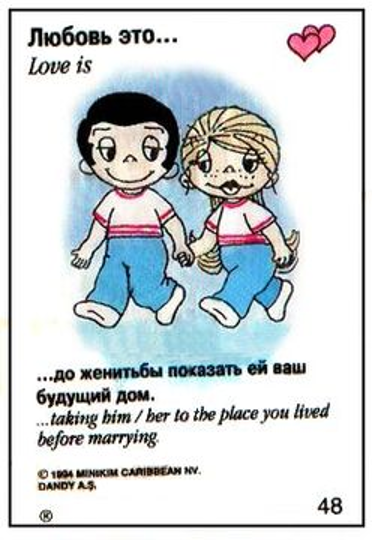Filed Under: Topic > Postsocialism > “Love Is…” chewing gum packaging insert, 1994.
“Love Is…” chewing gum packaging insert, 1994.

The English text reads: “Taking him/her to the place you lived before marrying.” The Russian text reads: “Showing her your future spousal house.”
The influx of capitalist goods into the post-Soviet market produced peculiar trends that are difficult to reconstruct today. One such trend was the omnipresence of chewing gum sold with a picture or sticker just inside the outer wrapper. These gums were popularized through the joint effort of international confectioner Chupa Chups and Turkish confectioner Kent, and were beloved by both children and adults during the early 1990s.
Gum was typically sold in individual pieces enclosed in two wrappers. The outer wrapper was disposable, but the one underneath was meant to be saved, either as a collectible or a decorative sticker. Most popular were major brands like Turbo and Love Is..., featuring glamorous vehicles and cheesy love quotes on their inserts, respectively, but a vast variety of similar products were also available with all sorts of tie-in media. As is apparent in this case, the translations were shoddy at best. While the English text reads, “Taking him/her to the place you lived before marrying,” the Russian text instead says “...Before marriage, show her your future house”— a strange replacement of a non-gendered and universal experience of sharing past memories with a partner, to a male-gendered gifting of a newly acquired future house. In this case, it is not clear if the mistranslation is a simple mistake, or a deliberate attempt to address a customer presumed to be more interested in the future than the past.
Gum was typically sold in individual pieces enclosed in two wrappers. The outer wrapper was disposable, but the one underneath was meant to be saved, either as a collectible or a decorative sticker. Most popular were major brands like Turbo and Love Is..., featuring glamorous vehicles and cheesy love quotes on their inserts, respectively, but a vast variety of similar products were also available with all sorts of tie-in media. As is apparent in this case, the translations were shoddy at best. While the English text reads, “Taking him/her to the place you lived before marrying,” the Russian text instead says “...Before marriage, show her your future house”— a strange replacement of a non-gendered and universal experience of sharing past memories with a partner, to a male-gendered gifting of a newly acquired future house. In this case, it is not clear if the mistranslation is a simple mistake, or a deliberate attempt to address a customer presumed to be more interested in the future than the past.
As an easily and readily available Western luxury good with no Soviet equivalents, gum and the accompanying colorful inserts became an important staple of post-Soviet children’s collecting, displacing stamps and other Soviet collection games. However, the imagery of these inserts was startlingly disparate: one kind of gum might include glossy stickers with pictures of cars and motorcycles, another stills from a popular Western film like Jurassic Park or The Godfather, while still others featured pornographic or erotic photographs or stickers. Whereas a Soviet stamp collection might consist of stamps featuring famous writers, space travel imagery, Socialist Realist paintings, birds, and dinosaurs, a gum-insert collection might include motorcycles, cheesy love quotes, porn, contextless scenes from The Godfather, and—dinosaurs.
This diversity of images exemplifies a notable quality of 1990s: the flood of Western media into the post-Soviet world was barely managed, such that there was no sense of impropriety in, for example, selling candy with pornographic imagery alongside candy with cartoon characters, or traumatically violent film scenes with no context or framing.